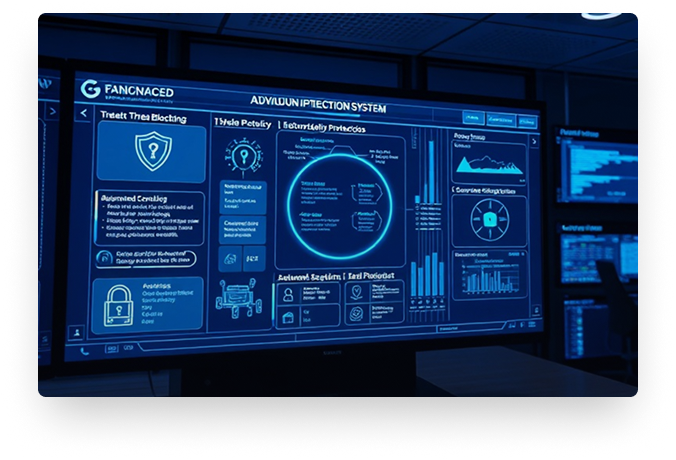Home » Our Business Fields » Network Security
Network security involves measures to protect the integrity, confidentiality, and availability of computer networks and data. It includes various technologies, policies, and practices designed to prevent unauthorized access, attacks, and disruptions to network infrastructure.
Network Uptime
Monitoring Coverage
Threat Response Time
Protect your network infrastructure with our advanced security technologies and expert
managed services
IDS is a system that monitors network traffic for signs of suspicious activity or known threats. It alerts administrators to potential security breaches or attacks but does not take action to stop them.
Key Features:


IPS is a network security system that monitors network traffic for malicious activity and can take automated action, such as blocking traffic, to prevent an attack from succeeding.
Key Features:
NAC refers to a set of technologies that enforce policies on devices trying to connect to a network. It ensures that only authorized devices, with the correct security posture, are allowed access to the network.
Key Features:


Network segmentation involves dividing a computer network into smaller, isolated segments to reduce the impact of a security breach and improve performance and management by controlling traffic flow between segments.
Key Features:
Cloud environment security focuses on securing cloud-based infrastructure, platforms, and services. It includes protecting data, applications, and services hosted in cloud environments from unauthorized access and cyber threats.
Key Features:


Corporate network security involves protecting the network infrastructure within an organization, ensuring that all internal and external communications are secure, and safe from potential cyber threats and unauthorized access.
Key Features:
Understanding the threats your network faces is the first step toward implementing effective security measures

Malicious software designed to damage, disrupt, or gain unauthorized access to network systems and data.

Attempts by cybercriminals to gain access to network resources without proper authentication or authorization.

Distributed Denial of Service attacks that overwhelm network resources and make services unavailable to legitimate users.

Security weaknesses in network infrastructure that can be exploited by attackers to compromise system integrity.

Unauthorized monitoring and capturing of sensitive data transmitted across network connections.

Social engineering attacks that trick users into revealing sensitive information or installing malicious software.
Our comprehensive network security solutions protect against all these threats and more
Discover how our network security solutions deliver measurable value to your business

Comprehensive protection against advanced threats with multi-layered security controls and continuous monitoring.
99.9% threat detection rate

Meet industry standards and regulatory requirements with automated compliance monitoring and reporting.
100+ compliance frameworks supported

Minimize potential entry points for attackers through network segmentation and access controls.
80% reduction in attack vectors

Ensure uninterrupted operations with high- availability security systems and rapid incident response.
99.99% uptime guarantee

Reduce security costs through automated processes, centralized management, and prevention of costly breaches.
40% reduction in security costs

Grow your security infrastructure alongside your business with flexible and scalable solutions.
Unlimited scalability
Join thousands of organizations that trust us to protect their critical network infrastructure
Our network security solutions include comprehensive features designed to protect your infrastructure

24/7 continuous monitoring of network traffic and security events with instant threat detection and alerting.

Unified dashboard for managing all network security components from a single, intuitive interface.

State-of-the-art encryption protocols to secure data in transit and protect against eavesdropping.

Built-in compliance frameworks for GDPR, HIPAA, SOX, PCI-DSS, and other regulatory requirements.

Flexible infrastructure that grows with your business needs without compromising security effectiveness.

24/7 technical support from certified security professionals with rapid response times.
Throughput Capacity
Latency Impact
Availability SLA
Support Coverage
Ready to secure your digital infrastructure? Get in touch with our experts for a customized solution.

Get the latest cybersecurity news, threat intelligence, and best practices delivered to your inbox.